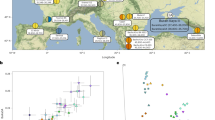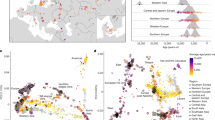Abstract
Neanderthals are thought to have disappeared in Europe approximately 39,000–41,000 years ago but they have contributed 1–3% of the DNA of present-day people in Eurasia1. Here we analyse DNA from a 37,000–42,000-year-old2 modern human from Peştera cu Oase, Romania. Although the specimen contains small amounts of human DNA, we use an enrichment strategy to isolate sites that are informative about its relationship to Neanderthals and present-day humans. We find that on the order of 6–9% of the genome of the Oase individual is derived from Neanderthals, more than any other modern human sequenced to date. Three chromosomal segments of Neanderthal ancestry are over 50 centimorgans in size, indicating that this individual had a Neanderthal ancestor as recently as four to six generations back. However, the Oase individual does not share more alleles with later Europeans than with East Asians, suggesting that the Oase population did not contribute substantially to later humans in Europe.
This is a preview of subscription content, access via your institution
Access options
Subscribe to this journal
Receive 51 print issues and online access
$199.00 per year
only $3.90 per issue
Buy this article
- Purchase on Springer Link
- Instant access to full article PDF
Prices may be subject to local taxes which are calculated during checkout


Similar content being viewed by others
References
Higham, T. et al. The timing and spatiotemporal patterning of Neanderthal disappearance. Nature 512, 306–309 (2014)
Trinkaus, E. et al. An early modern human from the Pestera cu Oase, Romania. Proc. Natl Acad. Sci. USA 100, 11231–11236 (2003)
Smith, F. H. et al. The assimilation model, modern human origins in Europe, and the extinction of Neandertals. Quat. Int. 137, 7–19 (2005)
Zilhão, J. Neandertals and moderns mixed, and it matters. Evol. Anthropol. 15, 183–195 (2006)
Hublin, J.-J. The modern human colonization of western Eurasia: when and where? Quat. Sci. Rev. 118, 194–210 (2014)
Green, R. E. et al. A draft sequence of the Neandertal genome. Science 328, 710–722 (2010)
Prüfer, K. et al. The complete genome sequence of a Neanderthal from the Altai Mountains. Nature 505, 43–49 (2014)
Sankararaman, S. et al. The date of interbreeding between Neandertals and modern humans. PLoS Genet. 8, e1002947 (2012)
Meyer, M. et al. A high-coverage genome sequence from an archaic Denisovan individual. Science 338, 222–226 (2012)
Wall, J. D. et al. Higher levels of Neanderthal ancestry in East Asians than in Europeans. Genetics 194, 199–209 (2013)
Kim, B. Y. & Lohmueller, K. E. Selection and reduced population size cannot explain higher amounts of Neandertal ancestry in East Asian than in European human populations. Am. J. Hum. Genet. 96, 454–461 (2015)
Vernot, B. & Akey, J. M. Complex history of admixture between modern humans and Neandertals. Am. J. Hum. Genet. 96, 448–453 (2015)
d’Errico, F. et al. Neanderthal acculturation in Western Europe? A critical review of the evidence and its interpretation. Curr. Anthropol. 39 (suppl.). S1–S44 (1998)
Mellars, P. The impossible coincidence: a single-species model for the origins of modern human behavior in Europe. Evol. Anthropol. 14, 12–27 (2005)
Fu, Q. et al. Genome sequence of a 45,000-year-old modern human from western Siberia. Nature 514, 445–449 (2014)
Seguin-Orlando, A. et al. Paleogenomics. Genomic structure in Europeans dating back at least 36,200 years. Science 346, 1113–1118 (2014)
Rougier, H. et al. Peştera cu Oase 2 and the cranial morphology of early modern Europeans. Proc. Natl Acad. Sci. USA 104, 1165–1170 (2007)
Constantin, S. et al. Reconstructing the evolution of cave systems as a key to understanding the taphonomy of fossil accumulations: the case of Urşilor Cave (Western Carpathians, Romania). Quat. Int. 339–340, 25–40 (2014)
Ackermann, R. R. Phenotypic traits of primate hybrids: Recognizing admixture in the fossil record. Evolutionary Anthropology: Issues, News, and Reviews 19. 258–270 (2010)
Frayer, D. in Continuity or Replacement? Controversies in Homo sapiens Evolution (eds Bräuer, G. & Smith, F. H. ) (A.A. Balkema Publishers, 1992)
Trinkaus, E. et al. Life and Death at the Peştera cu Oase. A Setting for Modern Human Emergence in Europe (Oxford Univ. Press, 2013)
Briggs, A. W. et al. Removal of deaminated cytosines and detection of in vivo methylation in ancient DNA. Nucleic Acids Res. 38, e87 (2010)
Fu, Q. et al. DNA analysis of an early modern human from Tianyuan Cave, China. Proc. Natl Acad. Sci. USA 110, 2223–2227 (2013)
Sawyer, S. et al. Temporal patterns of nucleotide misincorporations and DNA fragmentation in ancient DNA. PLoS ONE 7, e34131 (2012)
Meyer, M. et al. A mitochondrial genome sequence of a hominin from Sima de los Huesos. Nature 505, 403–406 (2014)
Skoglund, P. et al. Separating endogenous ancient DNA from modern day contamination in a Siberian Neandertal. Proc. Natl Acad. Sci. USA 111, 2229–2234 (2014)
Patterson, N. et al. Ancient admixture in human history. Genetics 192, 1065–1093 (2012)
Lazaridis, I. et al. Ancient human genomes suggest three ancestral populations for present-day Europeans. Nature 513, 409–413 (2014)
Reich, D. et al. Genetic history of an archaic hominin group from Denisova Cave in Siberia. Nature 468, 1053–1060 (2010)
Trinkaus, E. European early modern humans and the fate of the Neandertals. Proc. Natl Acad. Sci. USA 104, 7367–7372 (2007)
Dabney, J. et al. Complete mitochondrial genome sequence of a Middle Pleistocene cave bear reconstructed from ultrashort DNA fragments. Proc. Natl Acad. Sci. USA 110, 15758–15763 (2013)
Gansauge, M. T. & Meyer, M. Single-stranded DNA library preparation for the sequencing of ancient or damaged DNA. Nature Protocols 8, 737–748 (2013)
Briggs, A. W. et al. Patterns of damage in genomic DNA sequences from a Neandertal. Proc. Natl Acad. Sci. USA 104, 14616–14621 (2007)
Dabney, J. & Meyer, M. Length and GC-biases during sequencing library amplification: a comparison of various polymerase-buffer systems with ancient and modern DNA sequencing libraries. Biotechniques 52, 87–94 (2012)
Kircher, M., Sawyer, S. & Meyer, M. Double indexing overcomes inaccuracies in multiplex sequencing on the Illumina platform. Nucleic Acids Res. 40, e3 (2012)
Haak, W. et al. Massive migration from the steppe was a source for Indo-European languages in Europe. Nature 522, 207–211 (2015)
The 1000 Genomes Project Consortium. An integrated map of genetic variation from 1,092 human genomes. Nature 491, 56–65 (2012)
Paten, B., Herrero, J., Beal, K., Fitzgerald, S. & Birney, E. Enredo and Pecan: genome-wide mammalian consistency-based multiple alignment with paralogs. Genome Res. 18, 1814–1828 (2008)
Paten, B. et al. Genome-wide nucleotide-level mammalian ancestor reconstruction. Genome Res. 18, 1829–1843 (2008)
Raghavan, M. et al. Upper Palaeolithic Siberian genome reveals dual ancestry of Native Americans. Nature 505, 87–91 (2014)
Olalde, I. et al. Derived immune and ancestral pigmentation alleles in a 7,000-year-old Mesolithic European. Nature 507, 225–228 (2014)
Acknowledgements
We thank E. Trinkaus for facilitating the sampling of Oase 1, J. Krause for help with sampling and initial DNA analyses, A. Aximu for help with DNA hybridization captures and library preparation, and E. Trinkaus and L. Vigilant for critical reading of the manuscript. Q.F. is funded in part by the Chinese Academy of Sciences (XDA05130202) and the Special Foundation of the President of the Chinese Academy of Sciences (2015-2016). O.T.M. and S.C. are supported by the Romanian National Research Council through project PCCE 31/2010 (Karst Climate Archives). D.R. is supported by US National Science Foundation HOMINID grant BCS-1032255, US National Institutes of Health grant GM100233, and the Howard Hughes Medical Institute. The laboratory work was funded by the Presidential Innovation Fund of the Max Planck Society.
Author information
Authors and Affiliations
Contributions
N.P., K.P., M.M., J.K., D.R. and S.P. supervised the study. S.C. and O.T.M. collected and analysed archaeological material. Q.F., M.H. and B.N. performed laboratory work. Q.F., M.H., S.M., P.S., N.P., N.R., I.L., B.V., K.P., J.K. and D.R. analysed data. Q.F., S.M., M.M. and D.R. designed capture probes. D.R. and S.P. wrote the manuscript with the help of all co-authors.
Corresponding authors
Ethics declarations
Competing interests
The authors declare no competing financial interests.
Extended data figures and tables
Extended Data Figure 1 Mitochondrial DNA tree for Oase 1 and other modern humans.
The consensus sequences for all Oase 1 fragments and for deaminated fragments are shown. The tree is rooted with a Neanderthal mtDNA (Vindija33.25).
Supplementary information
Supplementary Information
This file contains Supplementary Notes 1-5 and Supplementary References. (PDF 1303 kb)
Supplementary Data
This file contains Supplementary Data 1a. (ZIP 24724 kb)
Supplementary Data
This file contains Supplementary Data 1b. (ZIP 24655 kb)
Supplementary Data
This file contains Supplementary Data 1c. (ZIP 23102 kb)
Supplementary Data
This file contains Supplementary Data 2a. (ZIP 23855 kb)
Supplementary Data
This file contains Supplementary Data 2b. (ZIP 23745 kb)
Supplementary Data
This file contains Supplementary Data 2c. (ZIP 23830 kb)
Supplementary Data
This file contains Supplementary Data 2d. (ZIP 12162 kb)
Supplementary Data
This file contains Supplementary Data 3a. (ZIP 25409 kb)
Supplementary Data
This file contains Supplementary Data 3b. (ZIP 25406 kb)
Supplementary Data
This file contains Supplementary Data 3c. (ZIP 25444 kb)
Supplementary Data
This file contains Supplementary Data 3d. (ZIP 25216 kb)
Supplementary Data
This file contains Supplementary Data 3e. (ZIP 25258 kb)
Supplementary Data
This file contains Supplementary Data 3f. (ZIP 17874 kb)
PowerPoint slides
Rights and permissions
About this article
Cite this article
Fu, Q., Hajdinjak, M., Moldovan, O. et al. An early modern human from Romania with a recent Neanderthal ancestor. Nature 524, 216–219 (2015). https://doi.org/10.1038/nature14558
Received:
Accepted:
Published:
Issue Date:
DOI: https://doi.org/10.1038/nature14558
This article is cited by
-
Differentiated adaptative genetic architecture and language-related demographical history in South China inferred from 619 genomes from 56 populations
BMC Biology (2024)
-
The Allen Ancient DNA Resource (AADR) a curated compendium of ancient human genomes
Scientific Data (2024)
-
Us and Them: How to Reconcile Archaeological and Biological Data at the Middle-to-Upper Palaeolithic Transition in Europe?
Journal of Paleolithic Archaeology (2024)
-
correctKin: an optimized method to infer relatedness up to the 4th degree from low-coverage ancient human genomes
Genome Biology (2023)
-
On Roth’s “human fossil” from Baradero, Buenos Aires Province, Argentina: morphological and genetic analysis
Swiss Journal of Palaeontology (2023)
Comments
By submitting a comment you agree to abide by our Terms and Community Guidelines. If you find something abusive or that does not comply with our terms or guidelines please flag it as inappropriate.



